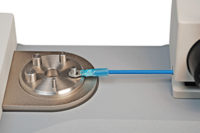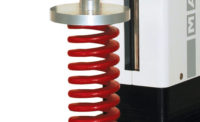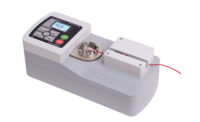Wire harness assemblies are used in numerous applications, from dishwashers to fighter jets. The common expectation with any wire is that it does not become disconnected from its crimped terminal after final installation. The process of wire crimp pull testing simulates such a failure, and indicates the maximum force required for detachment.
Wire crimp pull testing can be done manually or with a motorized tester. A test stand-based manual system consists of a test stand, force gage, and grips. Such systems are flexible because different force gage ranges can be specified and interchanged, and different grip types may be easily installed. Purpose-designed manual testers integrate the force sensor, display, terminal grip, and actuator into one housing. They are generally more portable; however, the force range cannot be easily changed.
Although manual testers are simple and economical, more stringent wire crimp pull test standards require a constant actuation speed. Since manual testers are subject to variations in pull speed, motorized testers allow for better sample comparisons. Specialized standards such as UL486A/B require a specified force to be held for a period of time, which can be done automatically by some motorized test stands.
With most manual or motorized testers, test results can be output to a PC. Many applications require only the peak force measurement, while some require a curve of force vs. time. Wire crimp pull testers are generally capable of capturing peak and continuous data, with the ability to store data onboard, and to output continuous data to a PC.
Wire crimp pull testing is an important step in achieving consistent product performance objectives and customer satisfaction. Given the importance of wire harnesses in many products and vehicles we rely on every day, it is important for manufacturers and OEMs to take such testing seriously.




